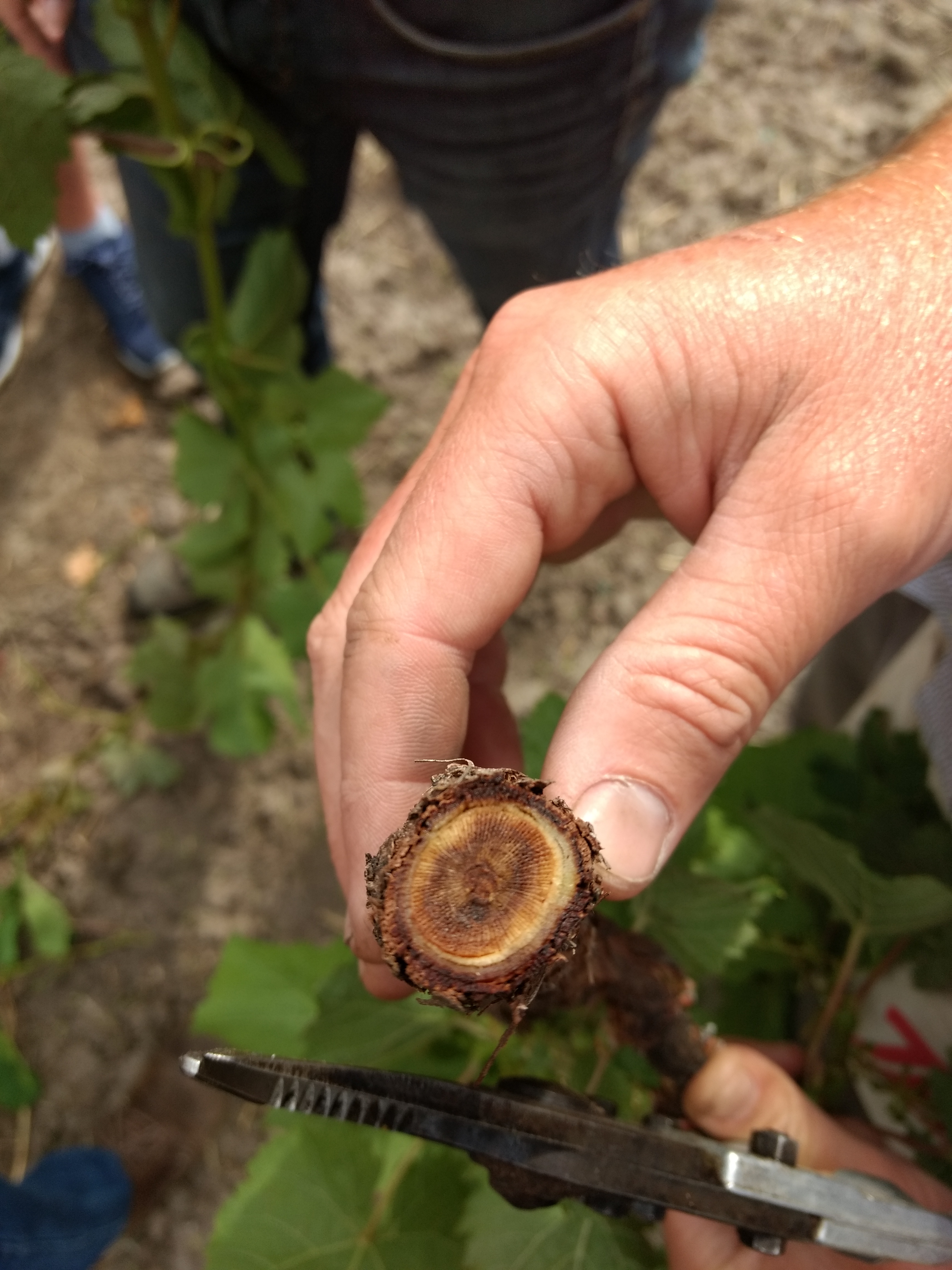Statement on Botryosphaeria in Minnesota Grapevines
Authors: Annie Klodd, Matt Clark, and Mike White. With input from John Thull, Jenny Thull, Mizuho Nita, and Tim Martinson.
During Dr. Richard Smart’s visit to the Horticultural Research Center on Monday, he discussed the common trunk disease botryosphaeria (“Bot canker”) and demonstrated it in several native and cultivated vines here. This fungal disease enters the vine through pruning cuts and injury, and gradually spreads through the vine over a number of years if not managed. It appears as brown streaks and cankers on the inside of woody tissue (xylem) (see photo).
Signs of the disease are not visible in the current year’s growth. Additional pathological testing is required to determine which fungal organism(s) are present and causing symptoms as there are numerous Botryosphaeria species and other trunk diseases like Phomoposis and Eutypa that can have similar symptoms. This includes the classic wedge-like canker in mature vines.
Impact on Minnesota Vines
Two important things to emphasize: 1) This trunk disease is not reason to panic, and grape growers around the world have been coexisting with it for many years. It is manageable, and does not warrant pulling out productive vines or cancelling orders. Energy should instead be focused on management. 2) It is unknown what percentage of vines Bot canker is present in, or what varieties are most susceptible. Research will be needed to determine the causal relationship between the presence of Bot canker and vine decline, including winter injury.
Bot canker is manageable through good sanitation after pruning, cordon replacement, and proper site selection. Bot that is not managed will eventually cause reduced yields, trunk die-back, and a shorter lifespan. These symptoms look similar to winter injury, and the two factors may be combining to lead to vine decline.
Botryosphaeria is common throughout the world, and grape industries in California, France, Italy, New Zealand, and others have successfully coexisted with it for quite some time. Now that we have a heightened awareness of this disease in Minnesota, we are able to improve our management practices in order to minimize its impact on our beautiful Minnesota vineyards.
Recommendations
Dr. Mizuho Nita is the grape pathologist at Virginia Tech who has been researching Botryosphaeria biology and management for many years. He is an authority on the subject. Here are some take-aways from a conversation with him this week:
1) Botryosphaeria is present in the air. It mainly enters vines through pruning wounds that are made when the air is humid, like after a rain.
2) He recommends pruning during dry conditions, and then spraying Rally or Topsin-M (fungicides) on the vines once the temperatures warm above freezing but before it rains.
3) Growers should grow up suckers to replace trunks and cordons if die-back occurs.
4) It infects the vine gradually over the course of 10-20 years. If vines are not stressed and they are managed well, they are often able to produce for years before showing decline.
5) Vine decline due to Botryosphaeria is typically observed on older vines; it can exist in the vines for a long time without causing damage. The two times Dr. Nita has seen decline on 3-4 year old vines were instances when they were pruned right before a rain, in the shade. Those are classic examples of disease conditions.
6) If the vines experience winter injury, the Bot infection may get worse because the vine is less healthy and therefore less able to tolerate infection.
When growers see vine decline in Minnesota, such as dead spurs, cordons,or trunks, this may be a combination of factors including Botryosphaeria, winter injury, management, and wet conditions. If you suspect Bot canker in your vineyard, the only way to truly confirm it is through lab analysis. Send a sample to the UMN Plant Diagnostic Lab, with a note that you suspect Botryosphaeria. Then if it is confirmed, follow the above recommendations about training up new suckers and replacing cordons as needed. Practice preventative measures including spraying Rally and Thompson after pruning (once temperatures are above freezing), and removing pruning debris from the field. Do not prune in wet conditions.
In addition, make sure that vines are grown in ways that minimize stress: Prune to the recommended spur counts for the variety, plant cold-hardy and disease-resistant varieties, and plant in well-drained sites (avoid planting in wetland and low-lying flat areas).
Stay tuned for further information. This is a new disease problem that has been brought to our awareness. Awareness is the first step in solving a problem. Further research and experience will shed more light on dealing with this disease in our cold climate region.
Please contact us with questions or if would like to discuss recommendations. Extension Educator Annie Klodd can be reached at [email protected].
